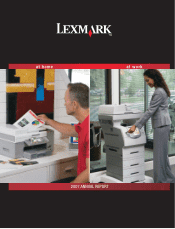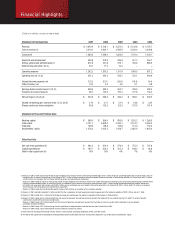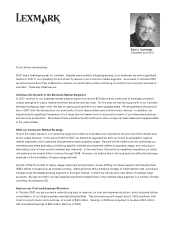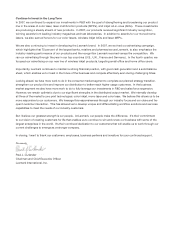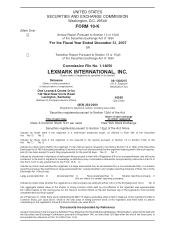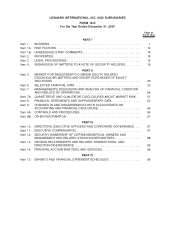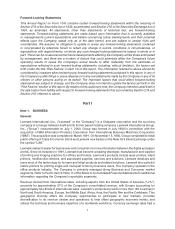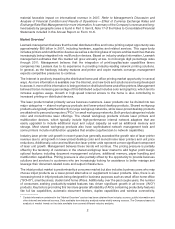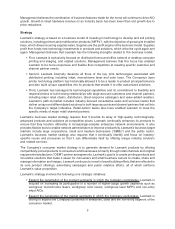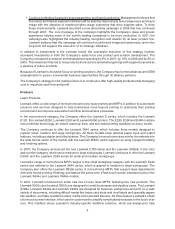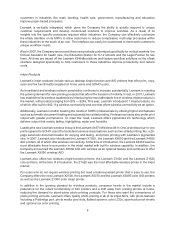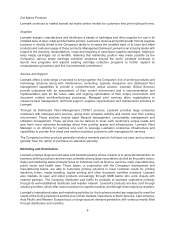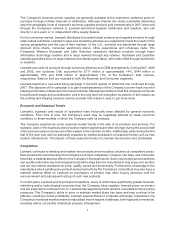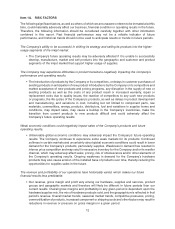Lexmark 2007 Annual Report Download - page 8
Download and view the complete annual report
Please find page 8 of the 2007 Lexmark annual report below. You can navigate through the pages in the report by either clicking on the pages listed below, or by using the keyword search tool below to find specific information within the annual report.
material favorable impact on international revenue in 2007. Refer to Management’s Discussion and
Analysis of Financial Condition and Results of Operations — Effect of Currency Exchange Rates and
Exchange Rate Risk Management for more information. A summary of the Company’s revenue and long-
lived assets by geographic area is found in Part II, Item 8, Note 17 of the Notes to Consolidated Financial
Statements included in this Annual Report on Form 10-K.
Market Overview
1
Lexmark management believes that the total distributed office and home printing output opportunity was
approximately $95 billion in 2007, including hardware, supplies and related services. This opportunity
includes printers and multifunction devices as well as a declining base of copiers and fax machines that are
increasingly being integrated into multifunction devices. Based on industry analyst information, Lexmark
management estimates that this market will grow annually at low- to mid-single digit percentage rates
through 2011. Management believes that the integration of print/copy/fax/scan capabilities favors
companies like Lexmark due to its experience in providing industry-leading network printing solutions.
In general, as the hardcopy industry matures and printer and copier markets converge, management
expects competitive pressures to continue.
The Internet is positively impacting the distributed home and office printing market opportunity in several
ways. As more information is available over the Internet, and new tools and solutions are being developed
to access it, more of this information is being printed on distributed home and office printers. Management
believes that an increasing percentage of this distributed output includes color and graphics, which tend to
increase supplies usage. Growth in high-speed Internet access to the home is also contributing to
increased printing on distributed devices.
The laser product market primarily serves business customers. Laser products can be divided into two
major categories — shared workgroup products and lower-priced desktop products. Shared workgroup
products are typically attached directly to large workgroup networks, while lower-priced desktop products
are attached to personal computers (“PCs”) or small workgroup networks. Both product categories include
color and monochrome laser offerings. The shared workgroup products include laser printers and
multifunction devices, which typically include high-performance internal network adapters that are
easily upgraded to include additional input and output capacity as well as additional memory and
storage. Most shared workgroup products also have sophisticated network management tools and
some printers include multifunction upgrades that enable copy/fax/scan to network capabilities.
Industry laser printer unit growth in recent years has generally exceeded the growth rate of laser printer
revenue due to unit growth in lower-priced desktop color and monochrome laser printers and unit price
reductions. Additionally, color and multifunction laser printer units represent a more significant component
of laser unit growth. Management believes these trends will continue. The pricing pressure is partially
offset by the tendency of customers in the shared workgroup laser market to add higher profit margin
optional features including document management solutions, additional memory, paper handling and
multifunction capabilities. Pricing pressure is also partially offset by the opportunity to provide business
solutions and services to customers who are increasingly looking for assistance to better manage and
leverage their document-related costs and output infrastructure.
The inkjet product market is predominantly a consumer market but also includes business users who may
choose inkjet products as a lower-priced alternative or supplement to laser products. Also, there is an
increasing trend in inkjet products being designed for business purposes such as small office home office
(“SOHO”), small business, student and home offices. Additionally, over the past couple years, the number
of consumers seeking productivity-related features has driven significant growth in all-in-one (“AIO”)
products. Key factors promoting this trend are greater affordability of AIOs containing productivity features
like full fax capabilities, automatic document feeders, duplex capabilities and wireless connectivity.
2
1
Certain information contained in the “Market Overview” section has been obtained from industry sources, public information and
other internal and external sources. Data available from industry analysts varies widely among sources. The Company bases its
analysis of market trends on the data available from several different industry analysts.

